|
1.
CENTRAL/ WEST AFRICA
Few changes in log prices as slow business continues
There have been few changes in the market situation since
the beginning of the month as Asian demand and price
stability has been maintained. There have been increases
in log prices for some species because of competition for
the same species from India, China and Vietnam. Okan
and padouk logs showed modest price gains. Buyers from
the Netherlands boosted demand for azobe logs and the
UK strengthened its demand for azobe sawn timber.
Overall, Europe has been very quiet, with very low
demand for logs and sawn lumber of any species. Italy has
stayed in the market much more consistently in the past
two months or so than almost any other European country
and has been enquiring for sawn, kiln dried okoume as
well as sawn iroko. A few orders for sapele are in hand in
special sizes for the Benelux buyers.
Okoume logs gained two or three euros per cubic meter on
steady demand from China. Vietnam was strongly in the
market for tali in logs and lumber, although the supply of
tali is quite limited. Okan was back in some favor and log
prices for the species increased slightly. India remains a
regular force in the current market with ongoing demand
for padouk, tali, sapele and belli.
Sawn lumber prices are unchanged. The small gains in the
past month have held while the species that lost ground,
sipo in particular, have not recovered.
Gabon is preparing for the election of a new President and
a large number of candidates have stepped forward. The
timber industry has been carefully watching the election
process as it is usually the President who determines wood
processing and other industrial priorities. Cameroon will
also hold presidential elections next year.
As the level of trade has held steady over the past two to
three months, some of the previous pressures to curtail
production have been reduced thanks to the stable prices
coupled with firm demand from Asian destinations.
Exporters do not believe there will be any substantial
revival in European buying through to the end of the
quarter and the prospects for the fourth quarter do not
appear bright. Possibly the best that can be expected from
Europe will be small, regular volumes in selected species
of sawn lumber, leaving the main business, as now, for
China, India and Vietnam.

2. GHANA
Government assures businesses in midst of recession
Ghana¡¯s Vice President John Mahama announced at a
roundtable discussion organized by the Graphic
Communications Group Limited (GCGL) in Accra that the
government was determined to tackle the global economic
recession head on. He said this would be done through
prudent fiscal and financial measures, to limit its negative
impact on businesses and ensure quick recovery of the
economy. In the Vice President¡¯s speech, he said some of
the measures being adopted include cuts in public
expenditure and robust resource mobilization. He clearly
emphasized that government would be careful to ensure
that the approaches do not harm the growth prospects of
businesses and put the economy on sound footing for
growth. Mr. Mahama said a key lesson from the crisis was
the need for government through its institutions to perform
oversight responsibilities adequately, adding that the
performance of the task should not interfere with the
growth prospects of businesses.
A tax advisor at the Ministry for Finance and Economic
Planning, Dr. Joseph Amoako Tuffuor, said because the
country¡¯s economy was vulnerable to external shocks,
there was a need to develop gate keeping measures to
mitigate any possible negative impacts on the local
economy. As a solution, he suggested streamlining
domestic tax revenue mobilization measures in order to
broaden the tax base and minimize tax deductions. It
would be recalled an at ITTO conference in Ghana last
month (see TTMR 14:12), the Vice President announced
the planned removal of taxes on timber and sawnwood in
an effort to boost the timber industry.
In another development, Governor of the Bank of Ghana
(BoG) Dr. Paul Acquah, said the economy was recovering
from economic challenges of the previous year.
Meanwhile, at the end of the second quarter, the Monetary
Policy Committee (MPC) of the BoG maintained its prime
rate at 18.5%.

3.
MALAYSIA
European trade representatives applaud Malaysia¡¯s timber industry
A visiting delegation of European timber trade
representatives to Sarawak called attention to the progress
made by the Malaysian timber industry to comply with EU
regulations. According to Bernama, the trip was organized
by the Sarawak Timber Industry Development
Corporation (STIDC) and the Malaysian Timber Council
(MTC).
Rachel Butler, head of sustainability for the UK Timber
Trade Federation, commended the Malaysian timber sector
for fast-tracking its compliance with EU requirements for
timber certification. She said current standards and
practices for sustainable production of timber in Malaysia
had placed the country a step ahead of a number of
tropical countries. Michele Eleoli, representing the Italian
Timber Federation, recommended Italian companies to
invest and set up factories in Malaysia in view of the
difficulties in finding skilled workers in Italy. Bert
Kattenbroek, representing the Dutch Association of
Joinery Companies, commented that its 250 member
companies consume about 120,000 m³ of tropical timber a
year, with 40% to 50% coming from Malaysia.
Green Furniture is key component of SIRIM¡¯s industrial research
SIRIM Bhd, a wholly government-owned company
involved in industrial research and development is gearing
up production of its ¡®green furniture¡¯ line as an alternative
to tropical timber furniture. Several prototypes of the
products had been developed under its advanced polymer
and composite programme, which utilizes a minimum of
60% of rice husk and rice straw bio-composite. Bernama
noted the target markets for SIRIM¡¯s Green Furniture will
be North America, Europe and the Far East and production
would be commercialized by 2010.
Morocco seen as attractive market for Malaysian furniture
Citing the popularity of Malaysian furniture in Morocco,
Mr. Othman Samin, Malaysian Ambassador to Morocco,
said Malaysian companies should consider participating in
the Moroccan construction and housing sectors. He called
attention to the ample opportunities for Malaysian timber
products manufacturers, reported Bernama. Total trade
between Morocco and Malaysia in 2008 was almost
RM234.2 million (USD65 million), with total Malaysian
exports reaching RM182.2 million (USD50.6 million).
Malaysian prices continue to fall
Malaysian timber prices remain depressed even as the two
economic stimulus packages announced earlier this year
have yet to make any impact on the local economy. The
spring remodelling and construction season in the northern
hemisphere has commenced, but many Malaysian timber
products manufacturers are still waiting for orders to come
in. Some manufacturers complained they have not had any
new orders for more than four months.
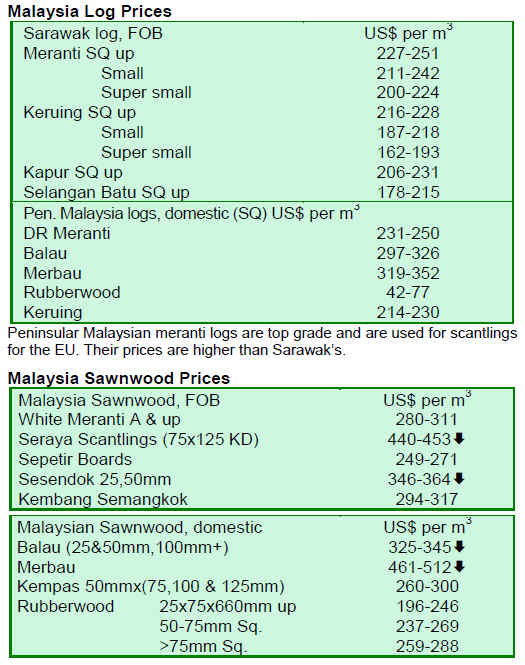
4.
INDONESIA
Indonesia and EU to sign new bilateral agreement
The Indonesia-European Union bilateral consultation
forum in Yogyakarta, Indonesia finalized a partnership
cooperation agreement (PCA) between the two partners.
According to Antara News, the PCA is the first bilateral
agreement signed between Indonesia and the EU. Apart
from promoting trade cooperation, the agreement also
covers environmental issues such as climate change. The
PCA will be signed before the end of this year.
The objective of the broader forum was to discuss several
areas of cooperation since the two trade partners¡¯ last
meeting in Brussels in September 2008. Bilateral trade
between Indonesia and the EU stood at about EUR20
billion. In addition, Indonesia and the EU agreed to lay the
ground work for the upcoming climate change
negotiations in Copenhagen in December 2009.
Asmindo to address export decline
A 20% decline in the exports of Indonesian furniture in the
first half of 2009 has prompted the Indonesian Furniture
Entrepreneurs Association (Asmindo) to stem the decline
in exports during the fourth quarter of 2009. Exports of
wood and rattan furniture declined from USD300 million
in the first half of 2008 to USD240 million during the
same period this year, noted The Jakarta Post.
The chairman of Asmindo, Mr. Ambar Tjahyono,
expected the value of exports of wooden and rattan
furniture to be worth USD372 million in the last quarter of
this year. Asmindo plans to improve results in the fourth
quarter by promoting sales in October, November and
December, the high season for furniture sales. Revenues
for the Christmas season are expected to double or triple.
Certified wood and rattan furniture are expected to add on
another 10% to sales prices. However, buyers are asking
for similar pricing regardless of certification. Only 160
Indonesian furniture exporters have obtained certification
out of a pool of 2,400 businesses. It takes up to six months
for a company to obtain certification, plus at a cost of Rp.
60 million (USD6,000) to Rp. 100 million (USD10,000).
Indonesia prices expected to hold steady
The early July bombings of two 5-star hotels in Jakarta are
not expected to erode prices of Indonesian timber products
further. Although corporate stock prices and the
Indonesian currency had declined as a result of the
tragedy, Indonesian timber prices are expected to hold for
the time being. Most buyers are staying away from the
country presently. But with Indonesian timber prices at a
record low, Indonesian timber products are expected to
maintain a favorable position in the international market
place. With renewed commitment by the Indonesian
government to address and maintain public and national
security, buyers are expected to return to the country by
the fourth quarter of 2009.

5.
MYANMAR
Plantation initiatives begin in Myanmar
The Ministry of Forestry announced its plan to establish
12,500 acres of plantations during fiscal year 2009-2010,
with a view to protect the environment. The
announcement, as reported in the Seven Day News, said
the measures would reduce soil erosion and siltation and
would sustain the availability of water in dams and
reservoirs in the watershed areas. The Ministry of Forestry
planted 21,650 acres of trees in these areas during fiscal
year 2008-2009. The Forest Department and the Dry Zone
Greening Department, both part of the Ministry of
Forestry, are jointly carrying out the plantation, protection
and conservation initiative.
Hardwood exports improve to India
The teak market is reported to be improving in India.
Other markets areas also show some signs of recovery,
though somewhat slight. Most analysts are cautious and
say it would be premature to make optimistic projections
at this juncture.
The pyinkado market is also reported to be good in India
and Vietnam, judging by Myanmar¡¯s shipments to these
countries. In contrast, padauk and tamalan is generally
shipped to China and Japan. Availability of these species
is limited and therefore prices are usually competitive.
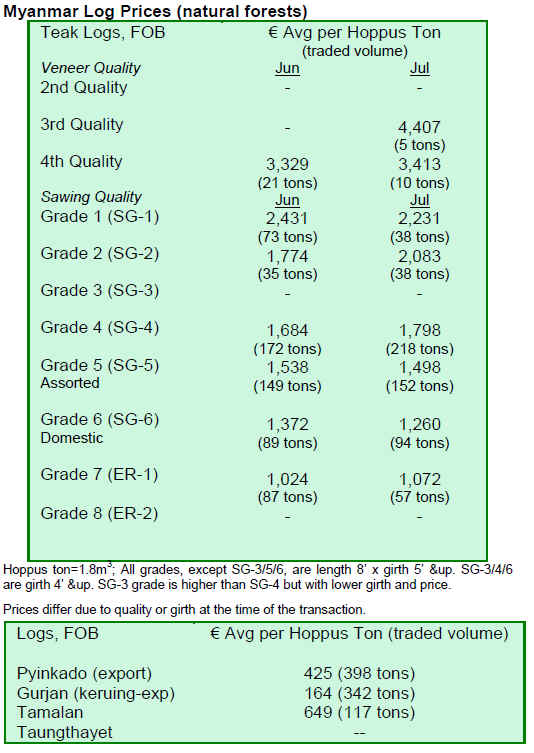
6. INDIA
MDF duties create challenges for importers
India¡¯s fiscal budget, presented on 6 July, introduced new
provisions to increase the central excise levy on plywood
from 4% to 8%, making imported plywood more
expensive. An anti-dumping duty on imported MDF (as
described below) will also remain in force. The following
duties on imported wood and wood products apply for
fiscal year 2009-10: timber logs, 9.35%; sawn timber,
14.71%; and plywood, veneer, fiberboard, softboard and
MDF, 24.42%.
The Government of India has provisionally imposed antidumping
duties on all imports of plain MDF boards of 6.0
mm and up thickness. Imports are mostly from Malaysia,
Thailand, New Zealand, Sri Lanka, and China. India has
three factories manufacturing MDF boards mostly
producing 6.0 mm and above thickness. Local production
was reported to be about 100,000 m³ of which imports
were 98,602 m³.
Investigations by government had shown that local
industry was not able to compete with imported quality
because many local factories had old technology in place.
The plant size of local factories is also much smaller
compared to the modern factories of other countries. Due
to significant increase in demand for plain MDF in the
country and with expectations of increasing profits, some
producers are also planning to establish new factories in
India.
Green Ply Limited representatives have recently said in
the June 2009 issue of Wood News that they have launched
India¡¯s largest MDF board plant with an annual capacity
of 180,000 m³ at a cost of USD53.20 million. This will be
the first continuous line and will be manufacturing plain
MDF and prelaminated MDF in thicknesses ranging from
2.5 mm to 30 mm with a range of dimensions. Currently,
MDF of 2.5 mm up to 5.5 mm is only supplied by imports.
The trial production is expected to commence by the end
of December 2009. It is expected that this unit will reduce
dependence on imports. The factory will be located at
Pant Nagar in Uttarakhand State of India.
Another development involves new wood-based industries
using plantation grown timber for their raw material
requirement. This has given a boost to the establishment of
new plantations, which in addition to increasing raw
material availability will also improve the environment.
One industrial company, ITC Limited, plans to be selfsufficient
in meeting raw material requirements in
manufacturing paper and related products. It manufactures
about 500,000 tons of paper and from 100,000 hectares of
eucalypts, su babul (Lucaena leucocephala spp.) and
casuarina. As at 30 June 2009, the company has about
95,000 hectares of plantations and is planning to expand
by 5,000 hectares. Currently, ITC imports about 130,000
tons of pulp but aims to be self-sufficient in pulp in the
next two years with raw material supplied by plantations.
The company has focused on expanding the plantations
with farmers and other communities for their mutual
benefit.
According to DNA Money, the company has been
approved by the United Nations Framework Convention
on Climate Change (UNFCCC) to receive carbon credits
under the project. The company has decided to pass on
these credits estimated at Rs.40 million to the farmers and
local communities participating in the project. This is
expected to generate an additional Rs.5000 per acre in
income for farmers.
Besides the efforts by the private sector, central
government is also encouraging the extension of forest
cover by releasing afforestation funds to States by utilizing
a compensatory afforestation fund management and
planning authority funds. The guidelines envisage a threetier
system involving central as well as state
representatives, reported the Economic Times. The
Supreme Court¡¯s order will unlock Rs.11200 in funds for
compulsory afforestation after a seven-year deadlock. It is
hoped that the differences between central and state
governments will be resolved soon and afforestation will
accelerate.
The Indian Prime Minister¡¯s visit to Malaysia and
meetings with Malaysian government officials has cleared
obstacles delaying the finalization of free trade agreements
among ASEAN countries and it was decided in principle
to proceed with a free trade pact. Effective 1 January
2010, the free trade agreements will include 4,000 items
on which tariffs will be reduced progressively over a
period of six years. The ten members of ASEAN are:
Brunei, Singapore, Cambodia, Laos, Indonesia, Malaysia,
Myanmar, Philippines, Vietnam and Thailand.
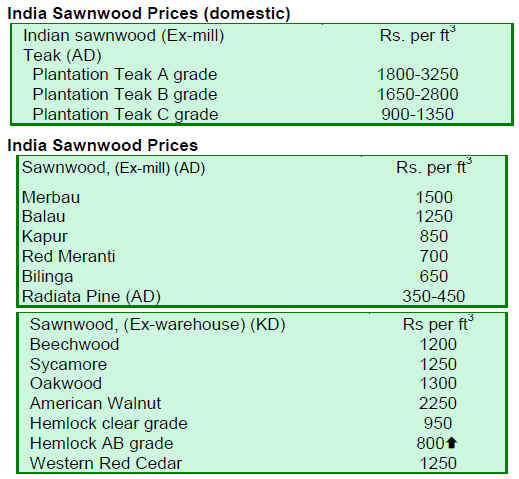
7. BRAZIL
Furniture sales plummet in Northern Mato Grosso
According to S¨® Not¨ªcias, furniture companies of Northern
Mato Grosso closed the first semester with a 50% fall in
the volume of traded furniture. The decline was due to the
effects of the global economic crisis, which has affected
different sectors of the economy since the end of 2008. In
the second half of the year, it is anticipated that furniture
sales will improve. In recent years, the furniture sector has
progress in various areas including rising sales. According
to research by the Brazilian Micro and Small Enterprises
Bureau (SEBRAE), the average revenue of companies
increased about 44% between 2006 and 2007. The
SEBRAE announced that the average income of
companies jumped from BRL 5.4 million to more than
BRL 7.8 million between 2006 and 2007.
INPA study points to overexploitation of commercial species
The high value of some Amazonian timber species, such
as mahogany, cedar and ipe, are damaging the forest and
wasting its economic potential, alerts the National Institute
for Amazonian Research (INPA). According to Globo
Amazônia, which reported on the INPA study, at least 150
timber species with commercial value have already been
identified for sustainable extraction. However, as there is
only a market for 15 of these commercial species, they
have been overexploited. Many of these species are
already scarce. There are many trees with commercial
potential that are still under utilized. The existing number
of 150 exploitable trees is still small. In total, there are
about 3,000 timber species catalogued.
Brazil¡¯s exports show no sign of improvement
Brazil¡¯s wood products exports for June 2009 (except pulp
and paper) plunged 41% by value compared to the same
period in 2008 similar to results published in May 2009,.
The charts below show the volume and value of Brazil¡¯s
exports for June 2009 compared to the same month a year
earlier:
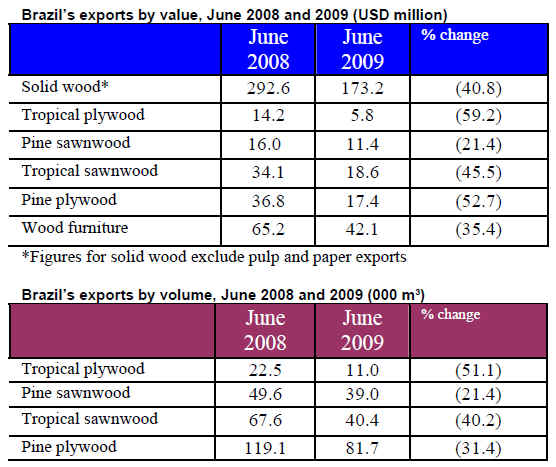
Alta Floresta¡¯s exports drop 48%
Exports from timber companies of Alta Floresta were 48.1
lower by product volume during the January to May 2009
period compared to the same period of last year. Timber
shipments, which in 2008 totaled USD8.4 million, were
USD4.3 million, according to the Ministry of
Development, Industry and Foreign Trade (MDIC).
Timber was the main product exported to different
countries, reported S¨® Not¨ªcias. Exports of sawnwood and
wood sheets (thickness greater than 6 mm) were
USD187,600, or 82.4% less than the January to May 2008
period. Nevertheless, this trend was reversed for exports of
doors, frames and sills, which increased 385.8%, up from
USD14,800 to USD71,900. The export of ¡®ipe¡¯ sawnwood
increased from USD43,100 to USD68,900, or a 59.8%
increase.
The largest importers of raw material from Alta Floresta
were the US (USD2.3 million), followed by Canada
(USD703,600), and Spain (USD424,200).
Rio Grande do Sul¡¯s furniture exports show continous drop
Updating figures from TTMR 14:13, furniture export
statistics from the state of Rio Grande do Sul (the largest
furniture producing state) fell 34.2% in the first half of
2009 from the same period in 2008, reaching USD91.0
million. At the national level, the drop was 33.2%, totaling
USD314.6 million.
According to MDIC-SECEX ¨C CGI Moveleiro, Cuba was
posted one of the highest percentage increases in imports
of Brazilian furniture, although this destination
represented only 3% of total furniture exports from Brazil.
Cuba increased its imports from Brazil by 85.5% over the
period and Rio Grande do Sul was the largest exporting
state to that country.
The US was the major destination of the Brazilian
furniture, receiving 15% of Brazil¡¯s total exports. The US
imported the equivalent of USD38.2 million, reducing its
imports to from Brazil by 48% from the same period in
2008. Argentina also reduced its furniture imports from
Brazil by 45.3%.
In June 2009, Brazilian exports of timber, pulp and paper
were worth USD540.65 million, an increase of 16.8%
compared to May 2009, when exports were USD462.88
million. The total value of Brazilian exports in June 2009
was USD131 million, representing a 2% decrease
compared to May 2009.

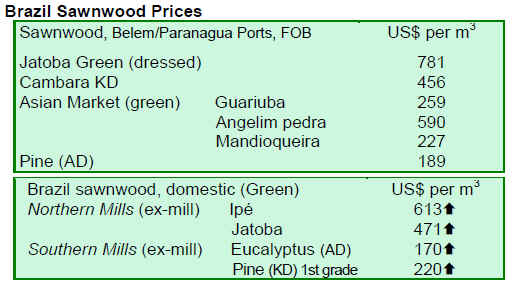
8.
PERU
Peru to contribute USD43 million to forest
conservation
Peru¡¯s Minister of the Environment Antonio Brack
recently noted that the Council of Ministers had approved
a project that plans to compensate native communities to
conserve forests in the total amount of USD43 million.
The programme is expected to be implemented beginning
August or September of 2009. Brack noted that through
this new programme native communities will be trained in
the care and monitoring of protected areas. He also
proposed the establishment of scholarships for university
studies as part of the project.
Trujillo and Arequipa to act as hosts to furniture industry fair
The cities of Trujillo and Arequipa will act as the hosts of
the FIMAT Furniture Industry Suppliers¡¯ Fair. Part of the
fair will take place in the city of Trujillo, from 13-15
August, and the city of Arequipa, from 20-22 August. As
the cities have been considerable growth markets for wood
products, they are well-suited to host the events, the first
time a sectoral exposition will be held both in the north
and south of Peru and directed at small, medium and large
scale industries. The fair will aim to promote a variety of
products, services and technology in the timber sector,
during which a variety of organized conferences and
technical meetings will be held.
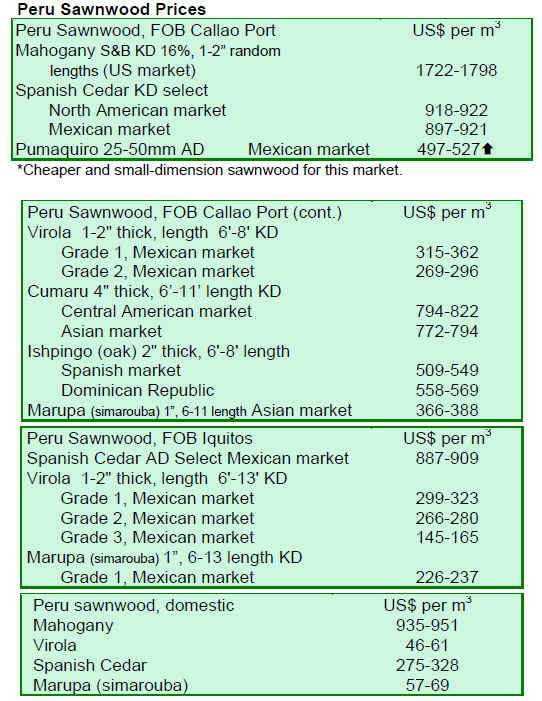
9. BOLIVIA
Business Roundtable to be held at the World Forestry
Congress in Argentina
The XIII World Forestry Congress, organized by the
Government of the Argentina under the auspices of the
Food and Agricultural Organization (FAO), will take place
from 18 - 23 October 2009 in Buenos Aires, Argentina.
Within the Congress, a Business Roundtable will be held
for the benefit of the private sector, which is expected to
provide a lively venue for the improvement of trade
relations in the forestry sector. The Business Roundtable,
which will be organized by FAO and the Forestry
Chamber of Bolivia, will take place on Wednesday, 21
October 2009, at La Rural in Buenos Aires and is expected
to attract around 400 businessmen and representatives of
forestry organizations from over 30 countries.
The objective of the event is to promote trade relations to
provide greater value to wood and other manufactured
goods. The event seeks to facilitate business contacts
between private sector actors from around the world. It is
anticipated that there will be significant participation in
the event by the forest and timber industry, including
private companies, machinery and equipment suppliers,
finance institutions, forestry and business development
organizations, consultants, business chambers and small
producers and other investors. Online registration is
available on the conference website under the section
'Business Events' (www.cfm2009.org).
Until 17 August, the registration fee for the Roundtable is
USD100, and USD 150 from 18 August onwards.
Participants registered to attend the whole week of the
WFC have free entrance to the business events and should
only fill in a registration form to attend the Roundtable.
For more information, please call + 591 3 333 2699 or
skype rondadenegocios or e-mail:
rondadenegocios@cfm2009.org .

10. MEXICO
BECC to fund environmental projects in Mexico
On 22 July, the Board of Directors of the Border
Environment Cooperation Commission (BECC) and the
Development Bank of North America (NADB) announced
that the Bank is fully capitalized and can now develop a
greater number of environmental projects in Mexico. The
BECC is an international organization established by the
governments of Mexico and the US works to support the
preservation, protection and improvement of the
environment in the US/Mexico border region to increase
the welfare of the population of both countries. The
development and implementation of the projects will be
conducted through a process of transparent binational
certification in a close coordination with the NADB,
international, federal, state and local governments, the
private sector and civil society.
11.
Guyana
Prices increase for popular log species
Prices have increased positively for greenheart,
purpleheart and mora logs (standard, fair and small
sawmill) over the 1-15 July 2009 period on average by
USD5 as compared to the 16-30 June 2009. Average
prices for undressed sawnwood greenheart (812/ 785)
were favorable, while prices for dressed sawnwood have
declined during the same period (1¨C15 July 2009) as
compared to the previous fortnight (16-30 June 2009).
Splitwood and roundwood prices have revealed stability in
the comparative period. The contribution of value-added
products, which includes doors, furniture and
prefabricated houses revealed positive export earnings
during the 1-15 July 2009 period with prices remaining
relatively stable, but highly favorable for the category of
prefab houses.
FPDMC to implement new work plan
In response to feedback obtained during a recently
concluded stakeholder meeting, the Forest Products
Development and Marketing Council (FPDMC) has
adopted a work plan comprising several program areas
aimed to take into account the feedback received. They
include efforts to make the forest sector ¡®market ready¡¯;
establish quality and legality assurance; promote markets
utilizing market intelligence research; develop lesser used
species; conduct training activities; and support initiatives
aimed at avoiding deforestation by promoting and
monitoring environmental and ecological services.
A survey is being conducted among individual
stakeholders to determine their market and product
development capabilities. The data from the survey will be
processed and presented where possible in synch with the
deliverables identified in the Council¡¯s work plan.
Commencing next week, FPDMC officials will be visiting
operators within the industry to ensure the circulated
stakeholder questionnaires are properly completed.
The Council, a government of Guyana not-for-profit
organization, is overseen by a Board of Directors
comprising of an equal number of representatives from the
private sector, stakeholder groups and government
agencies and an independent Chairperson. An Executive
Director manages the FPDMC¡¯s operations.
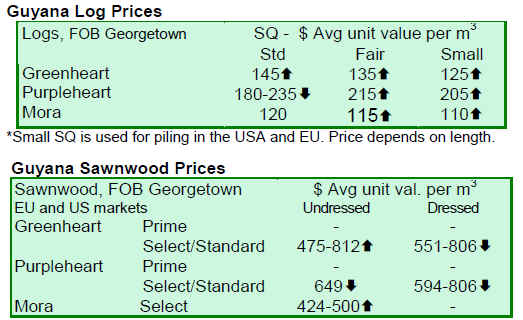
|